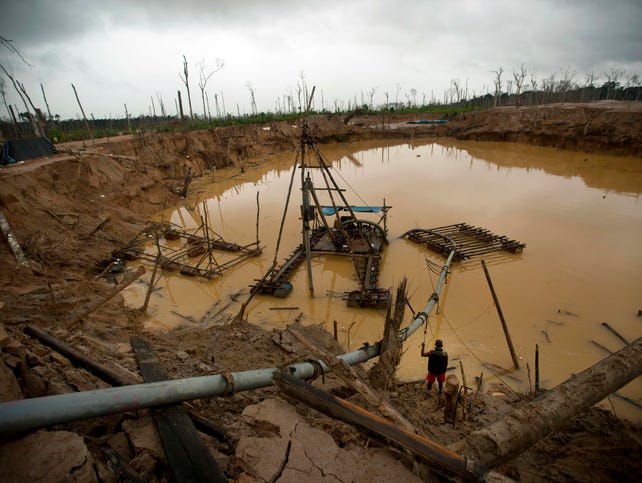Last year, we “smart” humans threw away 44.7 million metric tonnes of things with a plug or battery – everything from refrigerators and television sets to solar panels and mobile phones. To put that in more visual terms, imagine 1.23 million 18-wheel trucks filled to capacity with e-waste – enough trucks to line up bumper-to-bumper from New York to Bangkok and back. (A metric tonne is equal to around 1.1 US tons, or about 2,204 pounds.)
Given that we generated 8 percent more than we did just two years prior, things aren’t looking very good. And in fact, according to a new UN-backed report, we can expect to see a further 17 percent increase of e-waste, to 52.2 million metric tonnes, by 2021. E-waste is the fastest growing part of the world's domestic waste stream.
The new report, Global E-waste Monitor 2017 is a group effort between the United Nations University (UNU), represented through its Sustainable Cycles (SCYCLE) Programme hosted by UNU's Vice-Rectorate in Europe, the International Telecommunication Union (ITU), and the International Solid Waste Association (ISWA). The basic gist is that falling prices have made electronics affordable for most people worldwide; meanwhile, people in wealthier countries are being increasingly lured to buy early equipment replacement or new things altogether.
Here’s how it looks by the numbers:
9: The number of great pyramids that are equal in weight to the amount of e-waste generated last year.
20 percent: The amount of that e-waste that was recycled in 2016.
4 percent: The amount of 2016 e-waste known to have been thrown into landfills.
76 percent: The amount of 2016 e-waste that was incinerated, in landfills, recycled in informal (backyard) operations or remains stored in our households.
$55,000,000,000: The value of gold, silver, copper, other high value recoverable materials that were not recovered.
6.1 kilograms (13.4 pounds): The average amount of e-waste generated globally per person in 2016.
11.6 kilograms (25.5 pounds): The average amount of e-waste generated in the Americas per person in 2016.
17 percent: The amount of e-waste recycled in the Americas in 2016.
3: The number of electrical and electronic equipment categories that account for 75 percent of global e-waste by weight, and also expected to see the most growth:
Small equipment, like vacuum cleaners, microwaves, ventilation equipment, toasters, electric kettles, electric shavers, scales, calculators, radio sets, video cameras, electrical and electronic toys, small electrical and electronic tools, small medical devices, small monitoring and control instruments.Large equipment, like washing machines, clothes dryers, dish-washing machines, electric stoves, large printing machines, copying equipment, photovoltaic panels).Temperature exchange equipment, like refrigerators, freezers, air conditioners, heat pumps.
7.4 billion: The world population.
7.7 billion: The number of mobile-cellular subscriptions.
36 percent: The number of Americans who own a smartphone, a computer, and a tablet.
2 years: The far end of an average smartphone lifecycle in the USA, China, and major EU countries.
1 million tons: The weight of all the chargers for mobile phones, laptops et cetera, produced each year.
If there's a bright side to this dark mess, it's that more countries are adopting e-waste legislation, the report says, noting that 66 percent of the world's people live in the countries that have national e-waste management laws; an increase of 44 percent since 2014.
Also, although we’re making more and more stuff, some of it is getting smaller. Waste for small IT and telecommunication equipment (mobile phones, GPS, pocket calculators, routers, personal computers, printers, telephones, et cetera) is expected to grow less quickly by weight due to miniaturization.
Likewise, little growth is expected for lamps (fluorescent lamps, high intensity discharge lamps, LED lamps). And as heavy CRT screens for televisions, monitors, laptops, notebooks, and tablets are replaced with flat panel displays, e-waste from this category is expected to decline.
Just as Tom Waits sings, “you can never hold back spring,” so too can we not hold back digital progress. But we most certainly can make an effort to better design components used in electrical and electronic equipment, as well as devise better methods for recycling and recovering. All of which this report calls for.
"We live in a time of transition to a more digital world, where automation, sensors and artificial intelligence are transforming all the industries, our daily lives and our societies,” says Antonis Mavropoulos, President, International Solid Waste Association (ISW). “E-waste is the most emblematic by-product of this transition and everything shows that it will continue to grow at unprecedented rates. Finding the proper solutions for e-waste management is a measure of our ability to utilise the technological advances to stimulate a wasteless future and to make circular economy a reality for this complex waste stream that contains valuable resources. But first, we need to be able to measure and collect data and statistics on e-waste, locally and globally, in a uniform way. The Global E-Waste Monitor 2017 represents a significant effort in the right direction."
And of course, on a consumer level we can fight the cause of the problem: We can treat our equipment as if it were precious, not disposable. We can resist the siren song of shiny new things, take care of what we have, repair when we can and donate when we can't ... and when all else fails, recycle responsibly.


